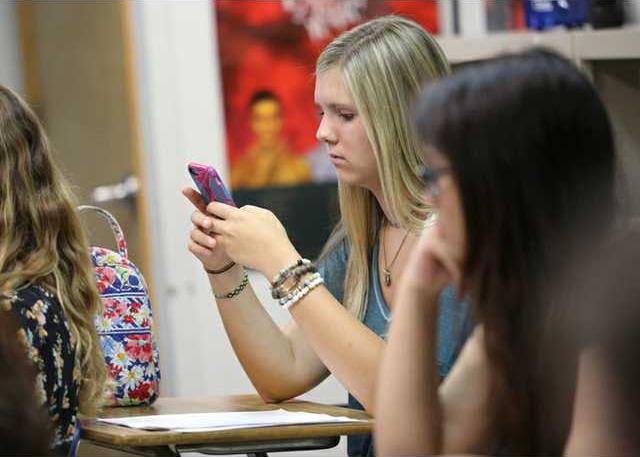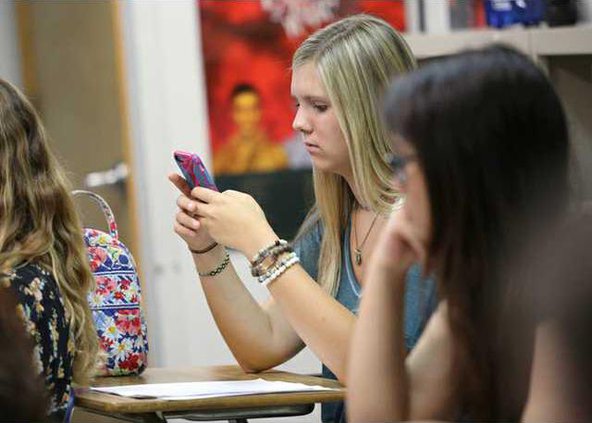Backpacks are no longer filled with calculators, CD players or pocket dictionaries. Today, all those things can fit in the palm of a student’s hand.
Cellphones, items at one point prohibited in the classroom, now are a staple.
At Gainesville High School, teachers offer quizzes, homework and interactive lessons using cellphones.
“I daily use technology of some kind,” said Lara Mallard, who teaches Advanced Placement language and composition at Gainesville High. “Often it’s students’ phones, but if they don’t have one, I have an iPad cart that stays in my room all the time. In my classes, we do some type of blended learning every day.”
Blended learning refers to the use of technology.
Dawn Jordan, assistant principal at Gainesville, said teachers have rules in place to ensure students are using their phones appropriately.
“Some teachers will tape a box on the sides of the students’ desks and the phone has to stay there,” Jordan said. “There are different ways to manage it and to keep it as a tool and not a toy.”
Jordan added that most teachers will collect phones at the beginning of a test, or make sure they are zipped away in backpacks.
In Hall County, high schools have policies outlined in the school agendas for cellphone usage.
Most schools, including North Hall, Flowery Branch, West Hall and East Hall high schools, allow cellphones to be used “at all times during the school day” except when permission is necessary in a certain class.
West Hall Principal Scott Justus said his teachers find innovative ways to use phones in class, particularly in art and photography classes.
Clay Sayre, visual arts teacher at Gainesville High, uses smartphone photography in one of his classes. Students take self-portraits on their phones, use an app to edit the images, and then recreate the images by hand with carefully chosen bits of paper.
A number of Hall teachers use Kahoot!, a website that allows students to create free accounts and play interactive learning games from their phones or other personal devices. The game then streams on the board for the whole class to watch together.
Mallard uses a similar program called Poll Everywhere, which allows students to submit multiple choice or short answer questions via text message. Mallard said this encourages students who would usually be too shy to raise their hand in class to participate in another way.
Leslee Valentin, junior at East Hall High, said she is on her phone “almost every class period” and can even do her assignments on her phone.
“When the teacher lets us, I’ll listen to music because it helps me concentrate while I’m working,” she said. “I also have all my school work on my phone and submit my work through my phone. We have an app called Canvas, and we can submit all our work through that.”
Valentin’s classmate Brody Crocker said not all of his teachers allow phones in the classroom, however.
“There are some teachers who oppose it, and there are teachers who encourage it for studying purposes and using it for class,” he said. “It depends on what kind of teacher you have and how they structure their class.”
The use of cellphones at school recently became much easier for students in the Hall system.
The district has nearly completed a systemwide Wi-Fi renovation, according to Aaron Turpin, executive director for technology. Middle and high schools have been updated, and the elementary schools will be done by Christmas.
“Every classroom has a dedicated Wi-Fi access point,” Turpin said. “And the general areas — cafeterias, gyms, theaters — have multiple access points. So each classroom has the capacity for a student to connect up to four devices at a time.”
It’s up to teachers and administrators to ensure students are connected to the school Wi-Fi, which is filtered, prohibiting some sites, including social media.
East Hall sophomore Tucker Williamson said he and his classmates are always on the Wi-Fi during class. But he said some students will get off the Wi-Fi between classes to check their Facebooks or Instagram accounts.
Valentin said most students use the time in between classes to socialize with one another.
Crocker said many high school students today “are dependent” on their phones at school.
“Some people really are here and using their phones for learning purposes,”he said. “But definitely many students rely on their phone so much that it would affect them a lot if they couldn’t use them throughout the day.”

